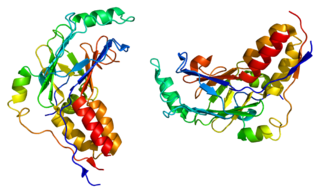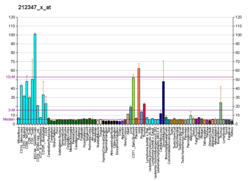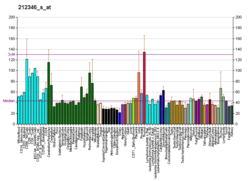
A basic helix–loop–helix (bHLH) is a protein structural motif that characterizes one of the largest families of dimerizing transcription factors. The word "basic" does not refer to complexity but to the chemistry of the motif because transcription factors in general contain basic amino acid residues in order to facilitate DNA binding.

Mothers against decapentaplegic homolog 3 also known as SMAD family member 3 or SMAD3 is a protein that in humans is encoded by the SMAD3 gene.
Myc is a family of regulator genes and proto-oncogenes that code for transcription factors. The Myc family consists of three related human genes: c-myc (MYC), l-myc (MYCL), and n-myc (MYCN). c-myc was the first gene to be discovered in this family, due to homology with the viral gene v-myc.

Myogenin, is a transcriptional activator encoded by the MYOG gene. Myogenin is a muscle-specific basic-helix-loop-helix (bHLH) transcription factor involved in the coordination of skeletal muscle development or myogenesis and repair. Myogenin is a member of the MyoD family of transcription factors, which also includes MyoD, Myf5, and MRF4.

N-myc proto-oncogene protein also known as N-Myc or basic helix-loop-helix protein 37 (bHLHe37), is a protein that in humans is encoded by the MYCN gene.

Transcription factor 3, also known as TCF3, is a protein that in humans is encoded by the TCF3 gene. TCF3 has been shown to directly enhance Hes1 expression.

Paired amphipathic helix protein Sin3a is a protein that in humans is encoded by the SIN3A gene.

DNA-binding protein inhibitor ID-1 is a protein that in humans is encoded by the ID1 gene.

YY1 is a transcriptional repressor protein in humans that is encoded by the YY1 gene.

MAX is a gene that in humans encodes the MAX transcription factor.

MAX-interacting protein 1 is a protein that in humans is encoded by the MXI1 gene.

Homeobox protein DLX-5 is a protein that in humans is encoded by the distal-less homeobox 5 gene, or DLX5 gene. DLX5 is a member of DLX gene family.

MAD protein is a protein that in humans is encoded by the MXD1 gene.

Max-like protein X is a protein that in humans is encoded by the MLX gene.

Poly(U)-binding-splicing factor PUF60 is a protein that in humans is encoded by the PUF60 gene.

MNT is a Max-binding protein that is encoded by the MNT gene

Prefoldin subunit 5 is a protein that in humans is encoded by the PFDN5 gene.

LIM homeobox transcription factor 1, alpha, also known as LMX1A, is a protein which in humans is encoded by the LMX1A gene.

Carbohydrate-responsive element-binding protein (ChREBP) also known as MLX-interacting protein-like (MLXIPL) is a protein that in humans is encoded by the MLXIPL gene. The protein name derives from the protein's interaction with carbohydrate response element sequences of DNA.

MAX dimerization protein 3 is a protein that in humans is encoded by the MXD3 gene located on Chromosome 5.























